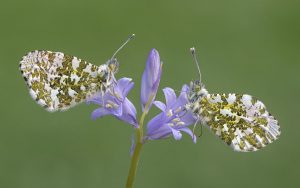24th October 2023
Tony North BPE5 DPAGB delivered an interesting and extremely detailed talk on the Art of Macro photography. Going into great detail about where and when to find suitable subjects and suggestions on how to overcome the challenges photographing them.
Tony started with the where and when to find butterflies and telling us to look out for areas with a variety of wildflowers and plants, and referred to the Butterfly Conservation website (butterfly-conservation.org). Note there is a specific Sussex page (butterfly-conservation.org/in-your-area/sussex-branch). The Butterfly conservation website has an enormous amount of information about where and when to find butterflies in the UK. Tony went through a few examples, highlighting the variation in when each species of Butterfly appears throughout the season.
Butterflies are ectothermic (having a body temperature that varies with the temperature of the surroundings) and thus need the sun in order to gain the energy to be active. Therefore, if the temperature is below 13ºC they won’t be flying and the best time to photograph them is early in the morning.
On the how to photograph butterflies, Tony started by highlighting the various factors effecting depth of field (Dof): focal length; aperture; and distance between the camera and the subject. Note: Tony also referred to the Photopills calculator for calculating the Macro depth of field (all calculators here: www.photopills.com/calculators).
He also pointed out that we should ensure our line of sight is perpendicular to the plane of our subject (or that the camera sensor should be parallel to the plane of our subject).
And finally, given the very narrow depths of field being used, the need to focus stack. To take multiple images of the same subject, where the focus point varies from the closest point of our subject to the furthest point, to ensure we have total coverage.
Camera movement is another challenge and Tony prefers to use a tripod, when the Butterflies are less active, and even to clamp the subject’s perch to ensure that everything remains still. A tripod is the most inflexible way of photographing butterflies and handheld being the most flexible, but more challenging.
Wind is the main issue impacting the subject’s movement and Tony only recommended going out when the wind speed is going to be less than 10mph. If it is a little breezy then look for subjects on sturdy plant stalks, and / or wait for lulls in the wind. As well as going out earlier in the day, Tony pointed out that mating subjects stay very still.
Tony generally uses shutter speeds between 1/100s – 1/200s and ISOs up to 1000 (but has been experimenting a little higher, with improvements in Denoise software). If the subject is too dark then consider artificial light, but be careful not to make the subject appear artificial. Tony also recommended using a reflector (a piece of white card with tin foil on one side is sufficient), if the subject is back lit. Note: When using denoising software, do this before stacking your images in your editing software.
Time of day. Mornings are the best time to photograph butterflies (although finding them can be difficult). It has the best light, but doesn’t suit all subjects (for example white butterflies). During the middle of the day, Butterflies are too active and it can still be warm at the end of the day.
Composition / Bokeh. For competition images Tony’s recommendations are: Subject clear and sharp throughout; Perch also sharp and well exposed; and background blurred, with some variation, but no distracting details (colours, light) and the colours complimenting the overall image.
Finally Tony went through some Advanced compositions (with examples): More than one subject; Environmental; Super close-up; Action; Multiple exposure; and Long exposure.
You can follow Tony on: Instagram (@tonynorth67); Flickr (tonynorth1); and Facebook (tony.north3). And finally Tony has his website: www.artofmacro.com, where you can see more of his great work.

